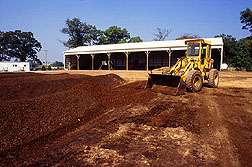Recycling Food Scraps into Gardens

Each weekday, food scraps are collected from the Maryland Food Distribution Authority in Jessup, Md., and from small local food service and marketing establishments. Materials that do not contain metal, glass, or plastic are trucked to the Agricultural Research Service (ARS) Henry A. Wallace Beltsville Agricultural Research Center (BARC) in Beltsville, Md.
There, they are mixed with woodchips, leaves and other organic residuals. Several months later, some of the finished compost is delivered to the National Mall for use in gardens at the U.S. Department of Agriculture (USDA) Jamie L. Whitten Federal Building.
For Patricia Millner, a microbiologist at the ARS Environmental Microbial and Food Safety Laboratory at BARC, this is part of research on ways to reduce the release of methane from landfills by diverting food residuals and other organic materials to composting. She conducts this research with microbiologist Walter Mulbry, who works in the ARS Environmental Management and Byproduct Utilization Laboratory at BARC.
In 2009, they are supplying compost to the inaugural “People's Garden,” part of a new program for creating a community garden at each USDA facility worldwide, as well as for landscaping at the U.S. Botanic Garden and the U.S. Capitol.
Millner also makes compost available for other federal “green” projects—such as roof gardens, rain gardens and other landscaping designs—to retain water and reduce runoff at federal sites in the Washington, D.C., metropolitan area.
As part of Millner’s efforts to help the federal government model ways to compost food scraps, she has a Cooperative Research and Development Agreement with RCM, LLC of Maryland to capture ammonia in the final compost to boost its nitrogen content for fertilizer use. She is comparing several types of insulated composting containers for greenhouse gas emission reduction and other cost-benefit characteristics.
Currently, about half of the carbon and nitrogen in composting materials is lost to the air, rather than being captured in the compost.
More information: You can about this and other research involving local food production and sustainable agriculture in the September 2009 issue of Agricultural Research magazine.
Provided by Agricultural Research Service















